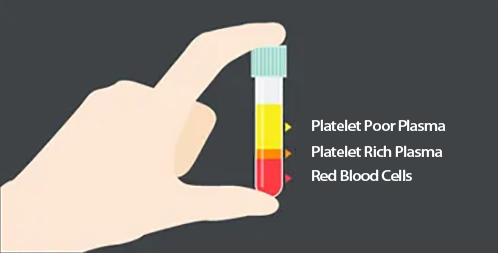Each blood cell type has unique uses and functions. Separating various blood components allows scientists to analyze specific cell types. For example, human white blood cells can be used to study immune function. such as cytokine production and surface marker expression. Other blood components can be used to detect disease. Once separated, blood cells can be further separated into subpopulations of cells.
Blood layers after centrifugation
The blood vessel after centrifugation shows 3 layers: a lower red layer containing red blood cells, a thin middle layer containing leukocytes, and an upper yellow layer containing platelets.

How does centrifugation separate blood components ?
Whole blood contains red blood cells, white blood cells, platelets, and plasma. The optimal blood separation technique will depend on which component is being isolated.
Separation of plasma from blood by centrifugation
The separation of plasma from blood usually occurs through centrifugation. The physical force from continuous revolutions pushes the denser, heavier particles to the outer edges of the sample resulting in three layers of different densities: RBCs, a mixture of WBCs and platelets, and plasma. The addition of a density separation medium can also cause the isolation of mononuclear cells and granulocytes from human blood.
Blood centrifugation and other blood separation techniques may leave behind residual RBCs, which can extend sort times and impede subsequent cell separation.
Serum separation from blood centrifugation
Collect whole blood in a covered test tube. After collection of the whole blood, allow the blood to clot by leaving it undisturbed at room temperature. This usually takes 15–30 minutes. Remove the clot by centrifuging at 1,000–2,000 x g for 10 minutes in a refrigerated centrifuge.
The resulting supernatant is designated serum. Following centrifugation, it is important to immediately transfer the liquid component (serum) into a clean polypropylene tube using a Pasteur pipette. The samples should be maintained at 2–8°C while handling. If the serum is not analyzed immediately, the serum should be apportioned into 0.5 ml aliquots, stored, and transported at –20°C or lower. It is important to avoid freeze-thaw cycles because this is detrimental to many serum components. Samples which are hemolyzed, icteric or lipemic can invalidate certain tests.
Separation of platelets from whole blood by centrifugation
During a platelet donation, called Apheresis, your whole blood is removed into sterile tubing and satellite bags. A machine called a centrifuge spins your blood to separate your red blood cells, platelets and plasma. As the blood is separated, the heavier reds cells sink to the bottom and are given back to you.
The liquid plasma rises and in between these two components is a layer of platelets that are tracked into a small pouch wrapped around the cylinder of the centrifuge.
You might want to know: density centrifugation of blood
After centrifugation of blood : Purpose
Each blood cell type has its own unique purpose and function. Separating the various blood components allows scientists to analyze specific cell types. Some blood components can be used to detect diseases, while others can provide a more comprehensive understanding of the human immune response. Blood separation allows researchers to study only the target cell population without any interference from other cell types.
Related Reading: Blood centrifugation process & procedure
